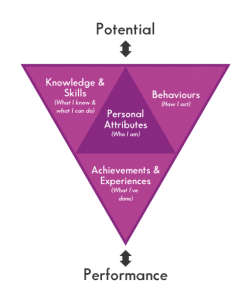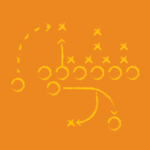
We know that effective talent management strategy is critical for organisational effectiveness. But how do you ensure you’re investing in the right people? This article discusses the importance of firstly defining talent, and ensuring a robust approach to identifying and assessing talent, that includes a focus on past performance as well as future potential.
Defining what talent looks like for your organisation
Before you spend your dollars on developing talent within your organisation, you need to first define it. What it looks like for one organisation may be quite different to another. The key questions we need to ask include:
- What are the critical skills, capabilities and experience your organisation needs to thrive?
- What drives success, now and in the future?
- What does a talented employee look like in your organisation?
Whilst the capabilities and skills may change, there are some fundamental considerations. A good way to think about it is as an equation, which I’ve used to help a number of organisations define talent. Simply, performance + potential = talent.
Both are equally as important as the other, however, you can’t have one without the other. The model below demonstrates the key elements of both.
Achievements and experiences – this will tell you what you need to know about past performance – what the employee has done and what they have achieved (here and in other organisations) and this can be assessed via performance appraisal and one-to-one interviews.
Personal Attributes– will inform both performance and potential – what behaviours, how often and how well does the employee demonstrate desired organisational behaviours. This will contribute to a measure of past performance but is also very predictive of how the employee will behave in the future, therefore, informing future potential.
Knowledge and Skills – will tell you what the employee knows and what they can do, including technical and non-technical capabilities. Those that are most important to you and your organisation will most likely be defined in capability frameworks, competency models and roles descriptions. They can be assessed via performance appraisal, work samples, aptitude tests and interviews with employees and their manager.
Personal Attributes – This is the kicker – and probably the most difficult to assess objectively. The key personal attributes that are critical to identifying talent in your organisation include self-awareness and emotional maturity, insight, learning capacity, and individual motivation/aspiration. How do we measure these attributes with precision? Behavioural styles and emotional intelligence assessments will provide a sound basis to identify and measure some of those personal attributes, however there remains a degree of personal judgment and subjectivity to round at the assessment.
Identifying Your Talent Pool
Once you’ve identified what talent looks like in your organisation, you need to design a process for identification and confirmation of your talent pool. As indicated above, in most cases, this will include a combination of formal and informal assessment and measurement tools including:
- Review of previous Performance Appraisals
- Interviews and discussions with individual employees and their managers
- Conduct of formal behavioural styles and emotional intelligence assessment
- Conduct and analysis of 360 degree feedback processes
- Aptitude tests and work samples
So what’s the most ideal blend of assessment tools? How detailed do you make the process? My advice is that it depends on the organisational situation. Your approach needs to be robust enough to ensure you are selecting the right people, but not over-engineered to the point that it is cumbersome.
If managers are involved in the assessment process, it is critical that they have a shared understanding of the assessment process and are trained in the use of interviewing techniques. Once an initial talent pool has been identified, you should also test it with the Senior and/or Executive Management Team as a whole, prior to confirmation.







